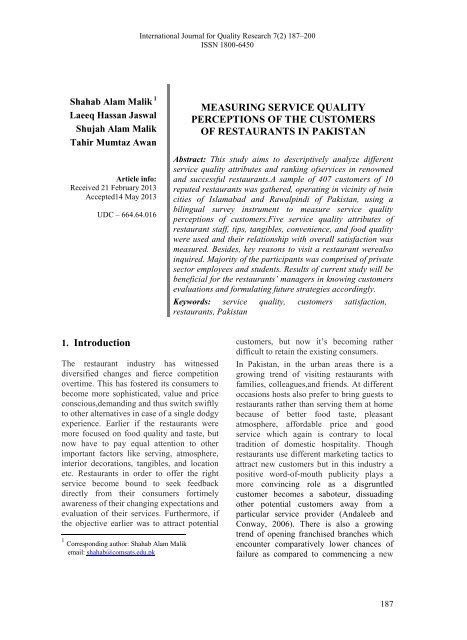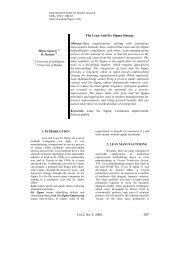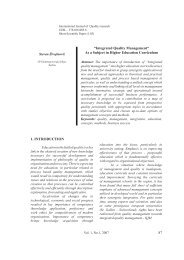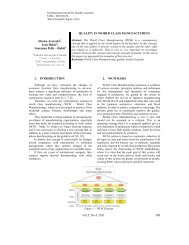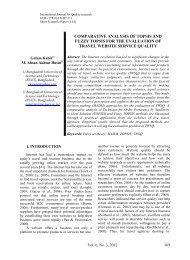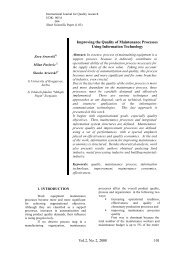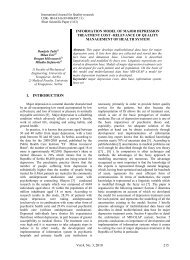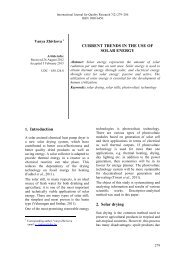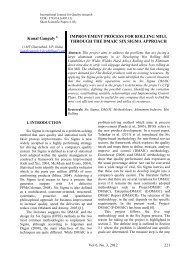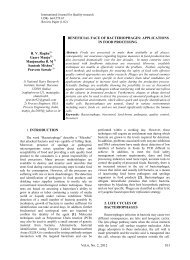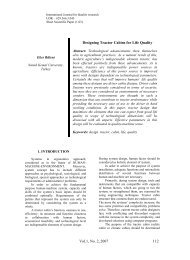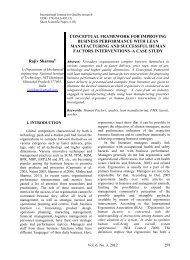measuring service quality perceptions of the customers of ...
measuring service quality perceptions of the customers of ...
measuring service quality perceptions of the customers of ...
Create successful ePaper yourself
Turn your PDF publications into a flip-book with our unique Google optimized e-Paper software.
International Journal for Quality Research 7(2) 187–200<br />
ISSN 1800-6450<br />
Shahab Alam Malik 1<br />
Laeeq Hassan Jaswal<br />
Shujah Alam Malik<br />
Tahir Mumtaz Awan<br />
Article info:<br />
Received 21 February 2013<br />
Accepted14 May 2013<br />
UDC – 664.64.016<br />
MEASURING SERVICE QUALITY<br />
PERCEPTIONS OF THE CUSTOMERS<br />
OF RESTAURANTS IN PAKISTAN<br />
Abstract: This study aims to descriptively analyze different<br />
<strong>service</strong> <strong>quality</strong> attributes and ranking <strong>of</strong><strong>service</strong>s in renowned<br />
and successful restaurants.A sample <strong>of</strong> 407 <strong>customers</strong> <strong>of</strong> 10<br />
reputed restaurants was ga<strong>the</strong>red, operating in vicinity <strong>of</strong> twin<br />
cities <strong>of</strong> Islamabad and Rawalpindi <strong>of</strong> Pakistan, using a<br />
bilingual survey instrument to measure <strong>service</strong> <strong>quality</strong><br />
<strong>perceptions</strong> <strong>of</strong> <strong>customers</strong>.Five <strong>service</strong> <strong>quality</strong> attributes <strong>of</strong><br />
restaurant staff, tips, tangibles, convenience, and food <strong>quality</strong><br />
were used and <strong>the</strong>ir relationship with overall satisfaction was<br />
measured. Besides, key reasons to visit a restaurant werealso<br />
inquired. Majority <strong>of</strong> <strong>the</strong> participants was comprised <strong>of</strong> private<br />
sector employees and students. Results <strong>of</strong> current study will be<br />
beneficial for <strong>the</strong> restaurants’ managers in knowing <strong>customers</strong><br />
evaluations and formulating future strategies accordingly.<br />
Keywords: <strong>service</strong> <strong>quality</strong>, <strong>customers</strong> satisfaction,<br />
restaurants, Pakistan<br />
1. Introduction 1<br />
The restaurant industry has witnessed<br />
diversified changes and fierce competition<br />
overtime. This has fostered its consumers to<br />
become more sophisticated, value and price<br />
conscious,demanding and thus switch swiftly<br />
to o<strong>the</strong>r alternatives in case <strong>of</strong> a single dodgy<br />
experience. Earlier if <strong>the</strong> restaurants were<br />
more focused on food <strong>quality</strong> and taste, but<br />
now have to pay equal attention to o<strong>the</strong>r<br />
important factors like serving, atmosphere,<br />
interior decorations, tangibles, and location<br />
etc. Restaurants in order to <strong>of</strong>fer <strong>the</strong> right<br />
<strong>service</strong> become bound to seek feedback<br />
directly from <strong>the</strong>ir consumers fortimely<br />
awareness <strong>of</strong> <strong>the</strong>ir changing expectations and<br />
evaluation <strong>of</strong> <strong>the</strong>ir <strong>service</strong>s. Fur<strong>the</strong>rmore, if<br />
<strong>the</strong> objective earlier was to attract potential<br />
1 Corresponding author: Shahab Alam Malik<br />
email: shahab@comsats.edu.pk<br />
<strong>customers</strong>, but now it’s becoming ra<strong>the</strong>r<br />
difficult to retain <strong>the</strong> existing consumers.<br />
In Pakistan, in <strong>the</strong> urban areas <strong>the</strong>re is a<br />
growing trend <strong>of</strong> visiting restaurants with<br />
families, colleagues,and friends. At different<br />
occasions hosts also prefer to bring guests to<br />
restaurants ra<strong>the</strong>r than serving <strong>the</strong>m at home<br />
because <strong>of</strong> better food taste, pleasant<br />
atmosphere, affordable price and good<br />
<strong>service</strong> which again is contrary to local<br />
tradition <strong>of</strong> domestic hospitality. Though<br />
restaurants use different marketing tactics to<br />
attract new <strong>customers</strong> but in this industry a<br />
positive word-<strong>of</strong>-mouth publicity plays a<br />
more convincing role as a disgruntled<br />
customer becomes a saboteur, dissuading<br />
o<strong>the</strong>r potential <strong>customers</strong> away from a<br />
particular <strong>service</strong> provider (Andaleeb and<br />
Conway, 2006). There is also a growing<br />
trend <strong>of</strong> opening franchised branches which<br />
encounter comparatively lower chances <strong>of</strong><br />
failure as compared to commencing a new<br />
187
estaurant with a new identity. This study<br />
thus has endeavored to observe different<br />
<strong>service</strong> related factors which play pivotal<br />
role in <strong>customers</strong>’ satisfaction.<br />
This article has been organized in <strong>the</strong><br />
following manner. After introduction<br />
section, an extensive literature review is<br />
narrated in which different scales used to<br />
measure <strong>service</strong> <strong>quality</strong> in restaurants and<br />
empirical findings <strong>of</strong> international and local<br />
researchers are discussed. The research<br />
methodology and <strong>the</strong> empirical analysis<br />
arepresented next, followed by discussion<br />
and conclusion. In <strong>the</strong> final section,<br />
limitations anddirections for future research<br />
are provided.<br />
2. Literature review<br />
SERVQUAL scale was <strong>the</strong> result <strong>of</strong> first<br />
conceptual model to measure <strong>service</strong> <strong>quality</strong><br />
developed by Parasuraman et al. (1985).<br />
SERVQUAL is an instrument to measure <strong>the</strong><br />
gap between <strong>the</strong> expectations and<br />
<strong>perceptions</strong> <strong>of</strong> <strong>customers</strong> by subtracting <strong>the</strong><br />
former from <strong>the</strong> latter. In its development,<br />
consumers rated more than hundred aspects<br />
<strong>of</strong> <strong>service</strong>, which researchers divided into ten<br />
categories/dimensions. For data collection a<br />
bank, acredit card company, a repair and<br />
maintenance company and a longdistancetelephone<br />
company were<br />
approached. These items were fur<strong>the</strong>r<br />
narrowed down to 31 and dimensions to 5<br />
namely reliability, assurance,<br />
responsiveness, tangibles and empathy<br />
(Parasuraman et al., 1988). This instrument<br />
was again refined by using it in five different<br />
customer samples and by comparing findings<br />
with those <strong>of</strong> o<strong>the</strong>r researchers who used<br />
SERVQUAL instrument (Parasuraman et al.,<br />
1991). Bojanic and Rosen (1994) measured<br />
<strong>service</strong> <strong>quality</strong> using <strong>the</strong> original<br />
SERVQUAL instrument in restaurants.<br />
SERVQUAL also received some serious<br />
criticism due to some <strong>the</strong>oretical and<br />
functional outcomes (Carman, 1990; Finn<br />
and Lamb, 1991; Brown et al., 1993; Buttle,<br />
1996). Cronin and Taylor (1992 and 1994)<br />
proposed SERVPERF as a substitute to<br />
SERVQUAL which only covers<br />
performance/satisfaction aspect <strong>of</strong> <strong>service</strong><br />
not expectations and which was supported<br />
by many researchers (Churchill and Boller,<br />
1992). Fonseca et al. (2010) shown how to<br />
improve <strong>service</strong> <strong>quality</strong> and customer<br />
satisfaction in public transport.<br />
Some researchers later developed <strong>service</strong><br />
<strong>quality</strong> scales especially with respect to<br />
restaurant industry. DINESERV was <strong>the</strong> first<br />
survey instrument used to measure factors <strong>of</strong><br />
restaurant importance (expectations Vs<br />
actual performance) developed (Stevens et<br />
al., 1995) using five attributes <strong>of</strong> <strong>service</strong><br />
namely assurance, empathy, reliability,<br />
responsiveness, and tangibles. (Raajpoot,<br />
2002) developed TANGSERV scale having<br />
more focus on certain aspects <strong>of</strong> tangibles,<br />
which he believed were missed in<br />
DINESERV scale. DINESCAPE was a sixfactor<br />
scale consisting <strong>of</strong> facility aes<strong>the</strong>tics,<br />
ambience, lighting, <strong>service</strong> product, layout,<br />
and social factors and was developed (Ryu<br />
and Chang, 2008) mainly related to physical<br />
environment <strong>of</strong> upscale restaurants. (Antun<br />
et al., 2010) developed DinEx scale which<br />
took domains <strong>of</strong> food, <strong>service</strong> and<br />
atmosphere and added two new dimensions<br />
<strong>of</strong> social connectedness and healthfulness to<br />
<strong>the</strong> model. Kafel and Sikora (2013)<br />
described results <strong>of</strong> research that had been<br />
conducted in small and medium companies<br />
in polish food sector. The aim <strong>of</strong> <strong>the</strong> research<br />
was to examine connection between usage <strong>of</strong><br />
<strong>quality</strong> management tools and methods and<br />
financial performance. In ano<strong>the</strong>r paper<br />
(Kafel et al., 2013) shown <strong>the</strong> planning in<br />
integration <strong>of</strong> management systems in polish<br />
organizations in food sector.<br />
Bojanic and Rosan (1994) used a<br />
SERVQUAL instrument to measure <strong>service</strong><br />
<strong>quality</strong> in a chain restaurant and used two<br />
questionnaires to measure expectations and<br />
<strong>perceptions</strong> separately for gap analysis.<br />
Expectations were found higher in all <strong>service</strong><br />
attributes from <strong>perceptions</strong> and in regression<br />
out <strong>of</strong> five <strong>service</strong> attributes namely<br />
188
tangibles, reliability, responsiveness,<br />
assurance and knowing <strong>the</strong> <strong>customers</strong>, only<br />
assurance, reliability and knowing <strong>the</strong><br />
<strong>customers</strong> were found significant.<br />
Researchers were <strong>of</strong> <strong>the</strong> view that consumers<br />
must be better educated about <strong>the</strong> <strong>service</strong> so<br />
that <strong>the</strong>y will have realistic expectations.<br />
Soriano (2001) examined four attributes<br />
namely <strong>quality</strong> <strong>of</strong> food, <strong>quality</strong> <strong>of</strong> <strong>service</strong>,<br />
cost/value <strong>of</strong> meal and <strong>the</strong> place which<br />
influence <strong>customers</strong>’ decisions to make a<br />
revisit for ano<strong>the</strong>r meal in Spanish<br />
restaurants. A ten-item questionnaire was<br />
used and a final sample <strong>of</strong> 3,872 <strong>customers</strong><br />
was used for analysis. Quality <strong>of</strong> food was<br />
<strong>the</strong> most important factor followed <strong>quality</strong> <strong>of</strong><br />
<strong>service</strong>, cost/value <strong>of</strong> meals and <strong>the</strong>n <strong>the</strong><br />
place to return to a restaurant. Similarly<br />
(Sulek and Hensley, 2004) found food<br />
<strong>quality</strong> as <strong>the</strong> only one <strong>of</strong> nine factorsbeing<br />
tested that had a significant effect on intent<br />
toreturn for 239 diners at an Irish-pub-style<br />
full-<strong>service</strong>restaurant in <strong>the</strong> sou<strong>the</strong>astern<br />
United States followed by dining atmosphere<br />
and seating-order fairness.<br />
Andaleeb and Conway (2006) used a ra<strong>the</strong>r<br />
different approach for data collection from<br />
restaurant <strong>customers</strong>. From telephone<br />
directory around 600 contacts were<br />
randomly selected and were sent survey<br />
questionnaires along with postage paid<br />
envelopes which returned with only 85<br />
(14%) response rate. To increase <strong>the</strong><br />
response rate above 100, 34 restaurant users<br />
were interviewed to make <strong>the</strong> total sample<br />
reach 119. Four <strong>service</strong> attributes namely<br />
responsiveness, tangibles, food <strong>quality</strong> and<br />
price were used and <strong>the</strong>ir effect on<br />
satisfaction was measured. In research<br />
findings, tangibles (physical design &<br />
appearance) was found insignificant.<br />
Responsiveness had <strong>the</strong> greatest impact on<br />
customer satisfaction followed by food<br />
<strong>quality</strong> and price respectively.<br />
In Pakistan a very short empirical literature<br />
is available about <strong>customers</strong>’ satisfaction<br />
with respect to <strong>service</strong> <strong>quality</strong> <strong>of</strong> restaurants<br />
industry. Khan and Shaikh (2011) studied<br />
relationship <strong>of</strong> two variables namely<br />
tangibles and responsiveness with<br />
<strong>customers</strong>’ satisfaction and used contents <strong>of</strong><br />
SERVQUAL and DINESERV for survey<br />
instrument. Data was ga<strong>the</strong>red from 400<br />
respondents from one federal capital and<br />
three provincial capitals <strong>of</strong> Pakistan.<br />
Responsiveness was found having a more<br />
significant relationship with customer<br />
satisfaction as compared to tangibles.<br />
(Ehsan, 2011) carried out research in three<br />
metropolitan cities <strong>of</strong> Pakistan about<br />
<strong>customers</strong> satisfaction with fast-food<br />
restaurants. A final sample 447 <strong>customers</strong><br />
was used for analysis and results showed that<br />
<strong>the</strong> <strong>customers</strong> considered price, variety <strong>of</strong><br />
food, promotional deals and timely <strong>service</strong><br />
as <strong>the</strong> important factors for <strong>the</strong> selection <strong>of</strong><br />
fast food restaurants.<br />
3. Research methodology<br />
Methodology<br />
This study aims to measure and observe<br />
<strong>customers</strong> satisfaction from <strong>the</strong> <strong>quality</strong> <strong>of</strong><br />
<strong>service</strong>s received from restaurants. Around<br />
500 questionnaires were distributed in 10<br />
restaurants operating in twin cities <strong>of</strong><br />
Islamabad and Rawalpindi, 50<br />
questionnaires in each restaurant using<br />
convenience sampling approach. Feedback<br />
<strong>of</strong> 423 respondents was received. A final<br />
sample <strong>of</strong> 407 respondents was used for data<br />
analyses after deleting incomplete<br />
questionnaires, representing aneffective<br />
response rate <strong>of</strong> 81.4%.<br />
Study was <strong>of</strong> cross sectional nature and data<br />
was collected from frequent visits to each<br />
restaurant and in different time slots (during<br />
lunch & dinner). Restaurants were selected<br />
cautiously on <strong>the</strong> basis <strong>of</strong> brand, experience<br />
and reputation. For data collection,first a<br />
formal permission was sought from <strong>the</strong><br />
restaurant management and <strong>the</strong>y were<br />
provided <strong>the</strong> questionnaires in envelopes.<br />
Management distributed and received filled<br />
questionnaires from respondents <strong>the</strong>mselves.<br />
Feedback was purely on voluntary basis and<br />
189
was sought when <strong>customers</strong> were given <strong>the</strong>ir<br />
bills after complete serving.<br />
Analysis<br />
The collected data was analyzed using IBM<br />
SPSS 19. For analysisboth regression and<br />
descriptive analyses were made. Correlation<br />
and regression were used to measure nature<br />
and strength <strong>of</strong> relationship <strong>of</strong> different<br />
<strong>service</strong>s <strong>of</strong>fered by <strong>the</strong> respective restaurants<br />
(Independent variables) and overall<br />
satisfaction <strong>of</strong> <strong>customers</strong> (Dependent<br />
variable). In descriptive analyses, bar<br />
diagram was used for reason(s) to visit that<br />
particular restaurant and ranking <strong>of</strong> <strong>service</strong>s<br />
from satisfaction perspective wasobserved.<br />
Data was carefully scrutinized through data<br />
screening. Wrong entries and outliers were<br />
rectified and missing values were treated<br />
using mean.<br />
Measures & Hypo<strong>the</strong>ses<br />
The questionnaire used in this study was<br />
newly designed in which all <strong>the</strong> contents <strong>of</strong><br />
<strong>the</strong> questionnaire were developed with an<br />
extensive consultation and guidance <strong>of</strong> some<br />
restaurant managers, <strong>the</strong>ir <strong>customers</strong> and<br />
literature. Before <strong>the</strong> questionnaire was<br />
finalized, four restaurant managers in full<strong>service</strong><br />
restaurants and one academic<br />
marketing senior faculty member reviewed<br />
<strong>the</strong> questionnaire for content validity. A<br />
small level pilot study was also carried out<br />
<strong>of</strong> around 60 <strong>customers</strong> from two restaurants<br />
to check <strong>the</strong> reliability, weaknesses and<br />
outcomes <strong>of</strong> <strong>the</strong> questionnaire.<br />
Five <strong>service</strong> <strong>quality</strong> attributes <strong>of</strong> restaurant<br />
staff, tips, tangibles, convenience, and food<br />
<strong>quality</strong> were developed and <strong>the</strong>ir relationship<br />
with overall satisfaction was measured,<br />
details <strong>of</strong> which are given in Table 1.<br />
Table 1. Operational definitions <strong>of</strong> independent and dependent variables<br />
Variables<br />
Operational definitions<br />
Overall satisfaction Satisfaction received from <strong>the</strong> overall <strong>quality</strong> <strong>of</strong> <strong>service</strong> provided to<br />
<strong>customers</strong>; <strong>the</strong> food <strong>quality</strong>; revisit intentions and recommending it to<br />
o<strong>the</strong>rs.<br />
Restaurant Staff<br />
Refers to <strong>customers</strong> satisfaction with subject to staff attitude,<br />
behavior, courtesy, responsiveness, and appearance etc.<br />
Tips<br />
It includes whe<strong>the</strong>r tips are expected by <strong>the</strong> staff and that whe<strong>the</strong>r<br />
<strong>service</strong> <strong>quality</strong> is effected by tips or o<strong>the</strong>rwise.<br />
Tangibles<br />
This section includes tangible facilities provided by <strong>the</strong> restaurant<br />
like appropriate parking, modern looking and visually appealing<br />
equipment and building and comfortable/hygienic environment etc.<br />
Convenience<br />
Includes convenience in terms <strong>of</strong> access to restaurant, necessary<br />
arrangements <strong>of</strong> disabled <strong>customers</strong>/children, resolving complaints<br />
and queries.<br />
Food Quality<br />
Refers to taste, <strong>quality</strong>, and freshness <strong>of</strong> meals and about variety <strong>of</strong><br />
menu.<br />
On <strong>the</strong> basis <strong>of</strong> above five types <strong>of</strong> <strong>service</strong>s,<br />
five hypo<strong>the</strong>ses were developed and <strong>the</strong>ir<br />
impact <strong>of</strong> overall satisfaction was measured.<br />
H1. The better <strong>the</strong> overall <strong>service</strong> <strong>of</strong> staff,<br />
<strong>the</strong> higher <strong>the</strong> level <strong>of</strong> <strong>customers</strong>’<br />
overall satisfaction is.<br />
H2. The higher <strong>the</strong> tips rewarded are, <strong>the</strong><br />
higher <strong>the</strong> level <strong>of</strong> <strong>customers</strong>’ overall<br />
satisfaction is.<br />
H3. The better <strong>the</strong> tangibles are provided,<br />
<strong>the</strong> higher <strong>the</strong> level <strong>of</strong> <strong>customers</strong>’<br />
overall satisfaction is.<br />
H4. The better <strong>the</strong> convenience is, <strong>the</strong> higher<br />
<strong>the</strong> level <strong>of</strong> <strong>customers</strong>’ overall<br />
satisfaction is.<br />
H5. The better <strong>the</strong> food <strong>quality</strong> is, <strong>the</strong> higher<br />
<strong>the</strong> level <strong>of</strong> <strong>customers</strong>’ overall<br />
satisfaction is.<br />
190
Questionnaire was bilingual in nature (Urdu<br />
and English) keeping into consideration <strong>the</strong><br />
lingual convenience <strong>of</strong> respondents. Each<br />
questionnaire carried statement<br />
expressing<strong>the</strong> purpose <strong>of</strong> <strong>the</strong> study,<br />
guaranteeing confidentiality, and<br />
emphasizing <strong>the</strong> voluntarynature <strong>of</strong> <strong>the</strong><br />
study.<br />
Questionnaire was comprised <strong>of</strong> three<br />
sections. Section-1 (32 items/questions) and<br />
2 (5 items) sought feedback about <strong>service</strong><br />
<strong>quality</strong> attributes and overall satisfaction<br />
respectively using five point Likert Scale<br />
ranging from 5=strongly agree to 1=strongly<br />
disagree for section-I and 5=very much to<br />
1=very less for section-II. Whereas Section-<br />
3 sought demographic information <strong>of</strong><br />
respondents asking nine questions related to<br />
gender, age, income, marital status,<br />
occupation, qualification, frequency <strong>of</strong> visit<br />
and preference to visit with.<br />
Total number <strong>of</strong> respondents were 407 in<br />
which male were 270 (66.3%) and female<br />
137 (33.7%) <strong>of</strong> <strong>the</strong> total. Majority <strong>of</strong> <strong>the</strong><br />
respondents fall in age group <strong>of</strong> 18-24<br />
(50.1%) and least in age less than 18 (2.5%).<br />
On <strong>the</strong> basis <strong>of</strong> marital status, majority <strong>of</strong><br />
respondents were single (65.6%) followed<br />
by married (33.9%) and engaged (0.5). A<br />
question about respondents monthly income<br />
was raised in which majority opted not<br />
applicable option (38.8%). According to<br />
employment status, majority were employee<br />
<strong>of</strong> private firms (34.6%) followed by<br />
students (32.2%). Education wise majority <strong>of</strong><br />
respondents were holding bachelors degree<br />
(45.7%) followed by masters (41.5%).<br />
According to frequency <strong>of</strong> visit to this<br />
particular question, majority <strong>of</strong> respondents<br />
visit this particular restaurant once a month<br />
(46.4%). Majority <strong>of</strong> visitors opts to visit<br />
restaurants with friends (48.4%) and family<br />
(43.7%).<br />
Results<br />
Demographic results are given in Table 2.<br />
Table 2. Demographic details<br />
Restaurants<br />
Demographic Variables<br />
(n = 10)<br />
f %<br />
Participants 407 100%<br />
Gender<br />
Male<br />
270 66.3<br />
Female<br />
137 33.7<br />
Age in years<br />
Less than 18 10 2.5<br />
18-24 204 50.1<br />
25 - 34 121 29.7<br />
35 - 44 49 12.0<br />
Above 45 23 5.7<br />
Marital Status<br />
Single<br />
267 65.6<br />
Married<br />
138 33.9<br />
Engaged<br />
2 0.5<br />
191
Monthly Income (Rs.)<br />
Less than 25,000 32 7.9<br />
25,001 - 30,000 36 8.8<br />
30,001 - 40,000 39 9.6<br />
40,001 - 50,000 53 13.0<br />
50,001 - 60,000 40 9.8<br />
60,001 and above 49 12.0<br />
Not Applicable 158 38.8<br />
Occupation<br />
Employee (Public) 40 9.8<br />
Employee (Private) 141 34.6<br />
Own Business 46 11.3<br />
Retired 5 1.2<br />
Unemployed 5 1.2<br />
House Wife 32 7.9<br />
Student 131 32.2<br />
O<strong>the</strong>r 7 1.7<br />
Education<br />
Middle/Secondary 1 0.2<br />
Matriculation 11 2.7<br />
Intermediate 31 7.6<br />
Bachelor 186 45.7<br />
Masters 169 41.5<br />
O<strong>the</strong>r 9 2.2<br />
Frequency <strong>of</strong> visit<br />
More than once a week 59 14.5<br />
Once a week 112 27.5<br />
Once a month 189 46.4<br />
Once a year 47 11.5<br />
Preference to visit restaurant with<br />
Friends 197 48.4<br />
Family 178 43.7<br />
Alone 23 5.7<br />
Official/Colleagues 9 2.2<br />
192
Figure 1 depicts information about reason(s)<br />
to visit that particular restaurant. According<br />
to results majority gives highest weightage<br />
to location (25.8%) followed by environment<br />
and <strong>service</strong> <strong>quality</strong> each (22.1%), food<br />
<strong>quality</strong> (19.9%), price (12.8%), o<strong>the</strong>rs<br />
(5.4%), interior (4.7%), play area for<br />
children (3.9%) and parking (1.7%).<br />
Figure 1. Reason(s) to visit this restaurant<br />
Table 3 displays correlation results along<br />
with number <strong>of</strong> items in each variable,<br />
Cronbach Alpha results, and Mean scores.<br />
Alpha scores range from 0.648-0.879 which<br />
are within acceptable range (Sekaran, 2006).<br />
Highest means scores was found <strong>of</strong> food<br />
<strong>quality</strong> (3.80) and least <strong>of</strong> Tips (3.26).<br />
Correlation results <strong>of</strong> all variables were<br />
positive and significant except <strong>of</strong> Tips,<br />
whose relationship was insignificant with<br />
restaurant staff, food <strong>quality</strong> and overall<br />
satisfaction. High correlation was observed<br />
between restaurant staff and tangibles<br />
(0.667) (p=0.01).<br />
Table 3. Cronbach Alpha, Means and Correlation Coefficients Results<br />
No. <strong>of</strong><br />
Alpha<br />
No.<br />
Variables<br />
M<br />
Items<br />
α<br />
1 Restaurant Staff 13 0.879 3.66<br />
2 Tips 2 0.648 3.26<br />
3 Tangibles 9 0.839 3.59<br />
4 Convenience 4 0.694 3.60<br />
5 Food Quality 4 0.783 3.80<br />
6 Overall<br />
Satisfaction<br />
5 0.775 3.76<br />
Correlation Coefficients<br />
1 2 3 4 5 6<br />
1<br />
0.047 1<br />
0.667 ** 0.140 ** 1<br />
0.529 ** 0.114 * 0.587 ** 1<br />
0.456 ** 0.013 0.485 ** 0.432 ** 1<br />
0.561 ** 0.047 0.592 ** 0.456 ** 0.649 ** 1<br />
**. Correlation is significant at <strong>the</strong> 0.01 level (2-tailed).<br />
*. Correlation is significant at <strong>the</strong> 0.05 level (2-tailed).<br />
193
Model summary, ANOVA and multiple<br />
regression results are given in Table 4 which<br />
show that <strong>the</strong> multiple regression coefficient<br />
(R), using all <strong>the</strong> predictors simultaneously,<br />
is 0.736 (R2 = 0.542) and <strong>the</strong> adjusted R2 is<br />
0.536, meaning that 54% <strong>of</strong> <strong>the</strong> variance in<br />
overall satisfaction can be predicted by <strong>the</strong><br />
independent variables (restaurant staff, tips,<br />
tangibles, convenience, and food <strong>quality</strong>).<br />
Independence <strong>of</strong> error terms was checked via<br />
Durbin-Watson which resulted 1.880, a<br />
value which fell between 1.5 and 2.50 and<br />
was found significant at p
estaurant staff expects tips (3.43). These<br />
results indicate that <strong>customers</strong> have to award<br />
tips to get a better <strong>service</strong> and <strong>the</strong>y give it<br />
even when <strong>the</strong>y are not satisfied with <strong>the</strong><br />
<strong>service</strong>. Participant restaurants were reputed<br />
ones and had majority <strong>of</strong> <strong>customers</strong><br />
belonging to middle and upper class only, so<br />
restaurant managers need to realize this<br />
aspect <strong>of</strong> tips too which is perceived in a<br />
negative manner by <strong>the</strong>ir <strong>customers</strong>.<br />
Convenience was <strong>the</strong> o<strong>the</strong>r independent<br />
variable that failed to predict significant<br />
relationship with overall satisfaction in<br />
regression results (β=0.029; t=0.661;<br />
p=0.509). The items included in this variable<br />
were related to easy access to restaurant,<br />
resolving guests’ complaints quickly,<br />
facilities for disabled persons, and easy<br />
access to restaurant information and<br />
facilities. Among <strong>the</strong>se, facilities for<br />
disabled persons received lowest mean score<br />
(3.48) along with restaurant good in<br />
resolving <strong>customers</strong>’ complaints (3.57)<br />
which shows that restaurants lack <strong>of</strong><br />
arrangements for disabled persons and don’t<br />
Table 5. The ranking <strong>of</strong> <strong>service</strong>s from satisfaction perspective<br />
taking seriously <strong>customers</strong> complaints cause<br />
low satisfaction <strong>of</strong> <strong>customers</strong>.<br />
Ranking <strong>of</strong> <strong>service</strong>s from satisfaction<br />
perspective was measured using mean scores<br />
showing ten <strong>service</strong>s each in ascending and<br />
descending order (Table 5). Customers<br />
ratedconsistent food <strong>quality</strong>, its fresh and hot<br />
serving, consistent good taste, correct order<br />
delivery <strong>the</strong> very first time followed by<br />
restaurant comfortable and hygienic<br />
environment and caring staff as <strong>the</strong> most<br />
satisfactory <strong>service</strong>s. Here majority <strong>of</strong><br />
<strong>customers</strong> agree that best satisfaction <strong>the</strong>y<br />
received from <strong>the</strong>ir favorite restaurant was<br />
from its food consistent <strong>quality</strong> and taste<br />
followed by o<strong>the</strong>r aspects <strong>of</strong> <strong>service</strong>s<br />
(tangible/intangibles) <strong>of</strong>fered by <strong>the</strong><br />
restaurant.<br />
Among <strong>the</strong> <strong>service</strong>s which were rated<br />
unsatisfactory included <strong>service</strong>s not provided<br />
properly without tips followed by overcrowded<br />
restaurants, insufficient parking<br />
area, tips expected by <strong>the</strong> staff, and no<br />
facility for disabled persons etc.<br />
Descending Order M M Ascending Order<br />
The <strong>quality</strong> <strong>of</strong> food is<br />
Services are not provided properly<br />
3.84 3.09<br />
consistent<br />
without tips<br />
Food served by restaurant is<br />
always hot/fresh<br />
3.83 3.39 Restaurant is never over crowded<br />
The food is tasty 3.80 3.40<br />
Sufficient parking area is available in <strong>the</strong><br />
restaurant<br />
Order delivery is performed<br />
correctly <strong>the</strong> first time<br />
3.80 3.43 Restaurant staff expect tips<br />
Restaurant has comfortable<br />
Restaurant provides convenience for<br />
3.77 3.48<br />
environment<br />
disabled guests<br />
Restaurant has hygienic<br />
Building <strong>of</strong> restaurant is visually<br />
3.76 3.52<br />
environment<br />
appealing<br />
The staff is caring 3.75 3.55 Services provided are prompt<br />
The menu has large variety <strong>of</strong><br />
meals/refreshments/desserts<br />
3.75 3.55 Toilet facilities are clean<br />
Cleanliness is maintained<br />
throughout <strong>the</strong> facility<br />
3.74 3.57<br />
Access to <strong>the</strong> restaurant is easy 3.69 3.58<br />
Restaurant is good in resolving guest<br />
complaints and compensating for <strong>the</strong><br />
inconveniences<br />
Rules and regulations are strictly<br />
maintained<br />
195
4. Conclusion<br />
In this study relationship <strong>of</strong> independent<br />
variables <strong>of</strong> restaurant staff, tangibles and<br />
food <strong>quality</strong> was found significant with<br />
overall satisfaction <strong>of</strong> <strong>customers</strong>, <strong>the</strong><br />
dependent variable, whereas o<strong>the</strong>r two<br />
variables tips and convenience failed to<br />
make any significant contribution. Tips<br />
showed negative and insignificant<br />
relationship in regression results which<br />
means that tips expectations from <strong>the</strong> staff<br />
and its connection with good <strong>service</strong> creates<br />
a negative impression on <strong>customers</strong>. Besides<br />
tips, convenience also showed insignificant<br />
relationship and some <strong>of</strong> its items also<br />
received low mean scores in ranking <strong>of</strong><br />
<strong>service</strong>s. In descriptive results, respondents<br />
rated location, <strong>service</strong> <strong>quality</strong>, environment<br />
and food <strong>quality</strong> <strong>the</strong> key reasons to visit that<br />
particular restaurant. In ranking <strong>of</strong> <strong>service</strong>s<br />
from satisfaction perspective, <strong>customers</strong><br />
ranked food <strong>quality</strong>, freshness, and taste<br />
followed by restaurant environment and<br />
caring staff as most satisfactory <strong>service</strong>s,<br />
whereas <strong>service</strong>s which were rated<br />
unsatisfactory included <strong>service</strong>s not provided<br />
properly without tips followed by overcrowded<br />
restaurants, insufficient parking<br />
area, tips expected by <strong>the</strong> staff, and no<br />
facility for disabled persons etc.The<br />
restaurant managers thus need to pay<br />
attention to <strong>service</strong> <strong>quality</strong> attributes that<br />
educe customer satisfaction as well as<br />
disheartens <strong>customers</strong> to make a revisit.<br />
5. Research limitations & future<br />
research<br />
There are certain limitations associated with<br />
this research that needs to be addressed<br />
especially generalizability. First, only<br />
selected numbers <strong>of</strong> restaurants were<br />
approached for data collection in which <strong>the</strong>re<br />
were ample chances that <strong>the</strong>ir <strong>customers</strong><br />
representonly a particular segment <strong>of</strong> society<br />
not all. Second, scope <strong>of</strong> research was<br />
limited as <strong>the</strong> data was collected from twin<br />
cities <strong>of</strong> Islamabad and Rawalpindi only, so<br />
results cannot be applied conclusively to <strong>the</strong><br />
whole restaurant sector <strong>of</strong> Pakistan. Third,<br />
though a bilingual questionnaire was used<br />
for participants’ lingual convenience (Urdu<br />
and English), but again sometimes exact and<br />
accurate translation is not possible. Fourth,<br />
<strong>the</strong> data was collected once during a year<br />
and in <strong>the</strong> autumn season and it took around<br />
two to three weeks in data collection, so had<br />
<strong>the</strong> data collected during o<strong>the</strong>r seasons, <strong>the</strong><br />
results could have been different. For future<br />
research, it is suggested that a more<br />
comprehensive study should be carried out<br />
including restaurants <strong>of</strong> o<strong>the</strong>r cities to<br />
enhance generalizability <strong>of</strong> results.<br />
Fur<strong>the</strong>rmore, <strong>the</strong> aspect <strong>of</strong> expectations<br />
should be included too at <strong>the</strong> time <strong>of</strong> arrival<br />
as in this study only <strong>perceptions</strong> were<br />
inquired after complete <strong>service</strong>.<br />
Annexure: The Service Quality Instrument (Section I & II)using five-point Likert Scale<br />
Independent Variables<br />
(Strongly Agree…………Strongly Disagree)<br />
1. Restaurant Staff<br />
A1. The staff is caring<br />
A2. Restaurant staff is helpful<br />
A3. The staff is responsive to <strong>customers</strong>' needs<br />
A4. The staff respond immediately when called<br />
A5. Services provided are prompt<br />
A6. The staff is courteous/disciplined/well trained<br />
A7. Order delivery is performed correctly <strong>the</strong> first time<br />
196
A8. I receive adequate information about <strong>the</strong> menu <strong>of</strong> <strong>the</strong> restaurant<br />
A9. The staff is willing to answer any questions<br />
A10. The staff has a clean appearance<br />
A11. Cleanliness is maintained throughout <strong>the</strong> facility<br />
A12. Rules and regulations are strictly maintained<br />
A13. Toilet facilities are clean<br />
2. Tips<br />
B1. Services are not provided properly without tips<br />
B2. Restaurant staff expect tips<br />
3. Tangibles<br />
C1. The restaurant has modern looking equipment<br />
C2. Sufficient parking area is available in <strong>the</strong> restaurant<br />
C3. Restaurant has comfortable environment<br />
C4. Restaurant has hygienic environment<br />
C5. Restaurant is never over crowded<br />
C6. Restaurant has good sitting arrangement<br />
C7. Building <strong>of</strong> restaurant is visually appealing<br />
C8. Equipment <strong>of</strong> restaurant is visually appealing<br />
C9. Materials associated with <strong>service</strong> (e.g., crockery) are visually appealing<br />
4. Convenience<br />
D1. Access to <strong>the</strong> restaurant is easy<br />
D2. Restaurant is good in resolving guest complaints and compensating for <strong>the</strong><br />
inconveniences<br />
D3. Restaurant provides convenience (necessary arrangements) for disabled guests<br />
D4. It is easy to get information about <strong>the</strong> facilities and <strong>service</strong>s <strong>of</strong> <strong>the</strong> restaurant<br />
5. Food Quality<br />
F1. Food served by restaurant is always hot/fresh<br />
F2. The menu has large variety <strong>of</strong> meals/refreshments/desserts<br />
F3. The <strong>quality</strong> <strong>of</strong> food is consistent<br />
F4. The food is tasty<br />
Overall Satisfaction (Dependent Variable)<br />
(Very Much………..Very Less)<br />
G1. Overall, how much satisfied are you with <strong>the</strong> <strong>service</strong> <strong>quality</strong> <strong>of</strong> this restaurant?<br />
G2. Overall, how much you like <strong>the</strong> food <strong>quality</strong> <strong>of</strong> this restaurant?<br />
G3. Your intentions to return to this restaurant in future?<br />
G4. Extent to which this restaurant matches your expectations?<br />
G5. Chances to recommend this restaurant to o<strong>the</strong>rs?<br />
References:<br />
Andaleeb, S. S., & Conway, C. (2006). Customer satisfaction in <strong>the</strong> restaurant industry: an<br />
examination <strong>of</strong> <strong>the</strong> transaction-specific model. Journal <strong>of</strong> Services Marketing, 20(1), 3-11.<br />
Antun, J. M., Frash, R. E., Costen, W., & Runyan, R. C. (2010). Accurately assessing<br />
expectations most important to restaurant patrons: The creation <strong>of</strong> <strong>the</strong> DinEX Scale. Journal<br />
<strong>of</strong> Food<strong>service</strong> Business Research, 13, 360-379.<br />
Bojanic, D. C., & Rosen, L. D. (1994). Measuring <strong>service</strong> <strong>quality</strong> in restaurants: An application<br />
197
for SERVQUAL instrument. Hospitality Research Journal, 18(1), 4-14.<br />
Brown, J. T., Churchill, A. G. Jr., & Peter, J. P. (1993). Improving <strong>the</strong> measurement <strong>of</strong> <strong>service</strong><br />
<strong>quality</strong>. Journal <strong>of</strong> Retailing, 69(1), 127-139.<br />
Buttle, F. (1996). SERVQUAL: review, critique, research agenda. European Journal <strong>of</strong><br />
Marketing, 30(1), 8-32.<br />
Carman, J. M. (1990). Consumer <strong>perceptions</strong> <strong>of</strong> <strong>service</strong> <strong>quality</strong>: An assessment <strong>of</strong> <strong>the</strong><br />
SERVQUAL dimensions. Journal <strong>of</strong> Retailing, 66(1), 33-55.<br />
Churchill, A. G. Jr., & Surprenant, C. (1982). An investigation into <strong>the</strong> determinants <strong>of</strong><br />
customer satisfaction. Journal <strong>of</strong> Marketing Research, 19(4), 491-504.<br />
Cronin, J. J. Jr., & Taylor, S. A. (1992). Measuring <strong>service</strong> <strong>quality</strong>: a reexamination and<br />
extension. The Journal <strong>of</strong> Marketing, 56(3), 55-68.<br />
Cronin, J. J. Jr., & Taylor, S. A. (1994). SERVPERF versus SERVQUAL: reconciling<br />
performance-based and <strong>perceptions</strong>-minus-expectations measurement <strong>of</strong> <strong>service</strong> <strong>quality</strong>. The<br />
Journal <strong>of</strong> Marketing, 58(1), 125-131.<br />
Ehsan, U. (2012). Factors important for <strong>the</strong> selection <strong>of</strong> fast food restaurants: an empirical<br />
study across three cities <strong>of</strong> Pakistan. British Food Journal, 114(9), 1251-1264.<br />
Fonseca, F., Pinto, S., & Brito, C. (2010). Service <strong>quality</strong> and customer satisfaction in public<br />
transports. International Journal for Quality Research, 4(2), 125-130.<br />
Finn, D. W., & Lamb, C. W. (1991). An evaluation <strong>of</strong> <strong>the</strong> SERVQUAL scales in a retailing<br />
setting. Advances in Consumer Research, 18(1), 483-490.<br />
Khan, N. R., & Shaikh, U. A. A. (2011). Impact <strong>of</strong> <strong>service</strong> <strong>quality</strong> on customer satisfaction:<br />
evidences from <strong>the</strong> restaurant industry in Pakistan. Management & Marketing, 9(2), 343-355.<br />
Kafel, P., & Sikora, T. (2013). The usage <strong>of</strong> <strong>quality</strong> management methods and tools in food<br />
sector organizations. Food. Science. Technology. Quality, 1(86), 204-216.<br />
Kafel, P., Nowicki, P., & Sikora, T. (2013). Planning in integration <strong>of</strong> management systems in<br />
polish organizations in food sector. Food. Science. Technology. Quality, 2(87).<br />
Lynn, M. (2001). Restaurant Tipping and Service Quality : A Tenuous Relationship. Cornell<br />
Hotel and Restaurant Administration Quarterly, 42(1), 14-20.<br />
Lynn, M., & Grassman, A. (1990). Restaurant tipping: an examination <strong>of</strong> three ‘rational’<br />
explanations. Journal <strong>of</strong> Economic Psychology, 11(2), 169-181.<br />
Neter, J., & Wasserman, W. (1974). Applied Linear Statistical Models. Homewood, IL:<br />
Richard Irwin.<br />
Parasuraman, A., Zeithaml, V. A., & Berry, L. L. (1985).A conceptual model <strong>of</strong> <strong>service</strong> <strong>quality</strong><br />
and its implications for future research. Journal <strong>of</strong> Marketing, 49, 41-50.<br />
Parasuraman, A., Zeithaml, V. A., & Berry, L. L. (1988). SERVQUAL: A multiple-item scale<br />
for <strong>measuring</strong> consumer <strong>perceptions</strong> <strong>of</strong> <strong>service</strong> <strong>quality</strong>. Journal <strong>of</strong> Retailing, 64(1), 12-25.<br />
Parasuraman, A., Zeithaml, V. A., & Berry, L. L. (1991). Refinement and reassessment <strong>of</strong> <strong>the</strong><br />
SERVQUAL scale. Journal <strong>of</strong> Retailing, 67(4), 420-450.<br />
Raajpoot, N. A. (2002). TANGSERV: A multiple item scale for <strong>measuring</strong> tangible <strong>quality</strong> in<br />
<strong>the</strong> food<strong>service</strong> industry. Journal <strong>of</strong> Food<strong>service</strong> Business Research, 5(2), 109-127.<br />
Ryu, K., & Jang, S.C. (2008). DINESCAPE: A Scale for Customers' Perception <strong>of</strong> Dining<br />
Environments. Journal <strong>of</strong> Food<strong>service</strong> Business Research, 11(1), 2-22.<br />
Sekaran, U. (2006). Research Methods for Business: A Skill Building Approach, (4 th Ed.),<br />
Wiley India Pvt. Limited.<br />
198
Snyder, M. L. (1976). The Inverse Relationship between Restaurant Party Size and Tip<br />
Percentage: Diffusion or Equity? Personality and Social Psychology Bulletin, 2(3) 308.<br />
Soriano, D. R. (2002). Customers' expectations factors in restaurants: The situation in Spain.<br />
International Journal <strong>of</strong> Quality & Reliability Management, 19(8), 1055-1067.<br />
Speer, T. L. (1997). The Give and Take <strong>of</strong> Tipping, American Demographics, 19(2), 51-55.<br />
Stevens, P., Knutson, B., & Patton, M. (1995). DINESERV: A tool for <strong>measuring</strong> <strong>service</strong><br />
<strong>quality</strong> in restaurants. Cornell Hotel and Restaurant Administration Quarterly, 36(2), 56-60.<br />
Sulek, J. M., & Hensley, R. L. (2004). The Relative Importance <strong>of</strong> Food, Atmosphere, and<br />
Fairness <strong>of</strong> Wait: The Case <strong>of</strong> a Full-<strong>service</strong> Restaurant. Cornell Hotel and Restaurant<br />
Administration Quarterly, 45(3), 235-247.<br />
Shahab Alam Malik<br />
COMSATS Institute <strong>of</strong><br />
Information Technology<br />
(CIIT)<br />
Pakistan<br />
shahab@comsats.edu.pk<br />
Laeeq Hassan Jaswal<br />
COMSATS Institute <strong>of</strong><br />
Information Technology<br />
(CIIT)<br />
Pakistan<br />
laeeq_hassan@comsats.edu.<br />
pk<br />
Shujah Alam Malik<br />
UniversitiTeknologi<br />
Malaysia (UTM)<br />
Malaysia<br />
shujah.alam.malik@gmail.c<br />
om<br />
Tahir Mumtaz Awan<br />
Sun Yat-senUniveristy<br />
China<br />
ctahir_mumtaz@comsats.edu.<br />
pk<br />
199
200


